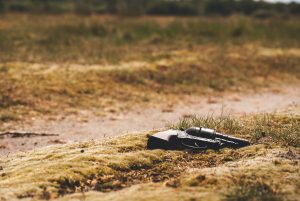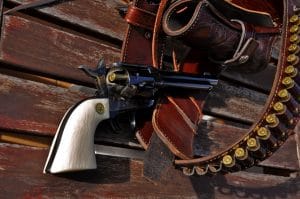The horrible shooting incident on the set of Alec Baldwin’s latest movie is at the top of the news today. A negligent discharge by the actor lead to the death of one crew member and serious injury of another. I wrote about what we know of the situation so far, and what lesson we can take away from it in a piece for The Atlantic.
I want to walk you through some of what I wrote and give you a few more insights into the main takeaway.
Early reports offered conflicting information. A spokesperson for Baldwin told the Associated Press that the gun in question was firing blanks. In an email to members of the International Alliance of Theatrical Stage Employees, the secretary-treasurer of IATSE Local 44 wrote that “a live single round was accidentally fired on set by the principal actor,” IndieWire reported.
It’s impossible at this point to draw any hard conclusions about precisely what went wrong. But whatever the specifics, there’s a simple lesson to be learned: Guns aren’t toys. Even props must be handled with respect for the harm they’re capable of inflicting. Training is required to operate any firearm safely, whether on set, at the range, or at home. And following gun-safety rules is always imperative.
A variety of different guns are used in film productions. Those include rubber guns that don’t function at all, airsoft guns with simulated blowback, blank-firing props, and even real functioning firearms. Blank-firing prop guns are designed to only work with blanks. Many have blocked barrels to prevent a projectile from being fired through them. Real guns used as props are sometimes modified in the same way. But live ammunition improperly loaded into either kind of gun could potentially overcome those precautions.
Productions often employ a trained professional to oversee the handling of any firearms, real or fake, precisely because they can be dangerous even when simple precautions such as keeping live ammunition away from set are followed. Blanks themselves can be dangerous if used improperly.
Blanks are usually cartridges that are manufactured without the inclusion of the bullet. They still feature a primer and powder charge, though, at about half the strength of a live round.
That means they still expel a lot of hot gas at a high rate of speed and can still be dangerous. This is especially true if something is lodged in the prop gun’s barrel that the charge can propel forward.
Fatal accidents have occurred with prop guns in the past. Most notably, Bruce Lee’s son was killed by somebody’s gun-handling mistake.
In 1993, Brandon Lee, the son of Bruce Lee, was filming a movie titled The Crow. During a scene in which the character he played was supposed to be shot, something went wrong, and Lee was killed. His autopsy revealed that he’d been hit with a .44-caliber bullet.
The details in Lee’s case are, to some degree, still disputed. We might never get a perfect explanation for what happened to him, and the same might be true for this latest tragedy.
This kind of negligence is exceedingly rare. Prop guns, blanks, and even real guns used as props are involved in entertainment productions every day without a problem. That is only the case when everyone handling the firearms, including the actors, both properly understand the risks involved in using them and follow the rules designed to mitigate those risks.
You should read the full piece over at The Atlantic, but all of this reinforces how important it is to understand what your firearms are capable of doing. And, why safety rules are so important.
I’m not saying that Alec Baldwin or the other people on this particular set don’t understand on some level that guns, even props, aren’t toys. I’m sure they had that basic understanding. But, it’s easy to make mistakes or get lazy with following the proper protocols when you feel you’re dealing with a lower level of danger than you really are.
This is exactly why we teach students in gun safety courses not to rely on a gun’s mechanical safety. They aren’t likely to fail but they can. And, if you let your guard down because a mechanical safety provides you with a false sense of security, you could easily end up hurting yourself or somebody else.
Making sure students don’t bring live ammunition to the classroom portion of the course is a similar precaution implemented for similar reasons.
That’s why we tell students to rely on the gun safety rules above all else. Never point a gun at anything you don’t want to shoot. Always keep your finger off the trigger until you are ready to fire. Always treat every gun as though it is loaded.
These rules are redundant on purpose. If you follow them, you will be able to avoid hurting anyone even when you experience a negligent discharge.
Guns, real and fake, are used safely on a daily basis across the country. These rules are not hard to learn or abide by. They are vital whether you’re on the shooting range or movie set.






